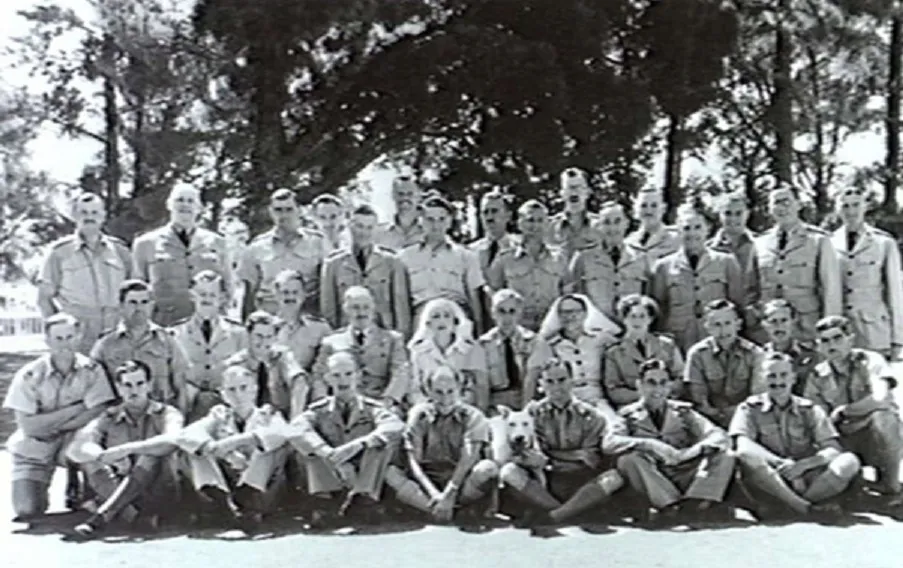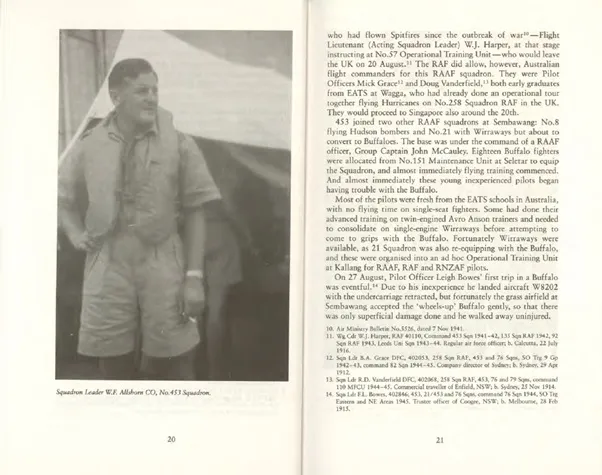

| Squadron/s | 453 SQN |
| Rank On Discharge/Death | Wing Commander (WGCDR) |
| Date of Birth | 20 Apr 1913 |
These notes mention William Allshorn:
17 Aug 41 - No 453 Sqn was the first "infiltration" or Article XV squadron to go into service in the Far East. On arrival it was formally established as a unit in the Far East Command with S/L Allshorn as temporary commanding officer.
Oct 41 - A RAF Officer, S/L Harper arrived from England to take command.
3 Oct 41 - Posted to command 21 Sqn and moved to Sungei Patani in north-western Malaya.
19 Nov 41 - Under the command of S/L Allshorn , 21 Sqn RAAF having completed its Buffalo training without any serious problems, was declared operational. Detached to Sungi Patani, Allshorn was not completely happy with the squadron's detachment to Sungei Patani, nor was he satisfied with the Buffalo, and later reported: "The Brewster Buffalo undercarriage once retracted gave frequent trouble on being lowered again, in as much as the undercarriage used to stick up in the locked position and the manual release devices were not efficient. The Squadron, however, had less trouble in this regard than some other similarly equipped units because the Commanding Officer published a definite cockpit drill for lowering and raising the wheels which seemed to get rid of most of the trouble. The armament is four .50 inch calibre machine guns, two of which were synchronized to fire through the airscrew. The armourers found great difficulty in ridding the electrical system of heavy corrosion and rusting in the short time which we had to become operational, and the squadron as a result never ever had efficient armament in spite of the fact that these guns on occasions tested well on the ground."
08 Dec 41 - The station operations room reported enemy aircraft approaching from the west at about 7 a.m., and the station commander called for two Buffalos to stand by and await instructions. Ten minutes later five Type-97 Japanese bombers appeared at 11000ft. Allshorn and the waiting pilots in the crew room ran towards their aircraft, putting on their parachutes and preparing to "scramble" and intercept. As they did so bombs began to explode on the opposite side of the airfield. Two more raids occurred during the day reducing the squadron strength to four serviceable Buffalos and Allshorn was ordered to withdraw the squadron to Butterworth.
09 Dec 41 - Frantic efforts were being made to get 21 Sqn four surviving Buffaloes serviceable, and by 1040 hrs, two were ready, F/O Geoff Sheppard’s (W8236) and Daryl Sproule (AN186) taking off to provide cover for a planned Blenheim raid on Singora. But, as S/L Allshorn reported, the bombers failed to appear: "I produced two aeroplanes which, after being briefed by Butterworth Ops Officer, took off at the appointed time, flew around for 40 minutes in the vicinity of the aerodrome at rendezvous height and reported back to me that the Blenheims had not taken off."
10 Dec 41 - Squadron moves to Ipoh. Allshorn seeks replacement aircraft from Wg Cdr Forbes RAF and Wg Cdr Wright at RAAF Sembawang.
14 Dec 41 - Back in Singapore, S/L Allshorn was still struggling to get the replacement Buffaloes ready for operations. During the day all six aircraft were flown over to Sembawang, where the guns had to be re-harmonised and work on brakes had to be carried out because the staff at Seletar were not available. The aircraft were finally deemed ready that evening and were prepared for an early departure on the 15 December, as recalled by Allshorn:
"I rang Group Captain Rice that evening and told him that I had advice that weather would prevent me departing the next morning. He informed me that I was to leave no matter what the weather was like. This I did, at 0600 hrs. After taking off, with F/L Kinninmont as my No 2, the six aircraft left the circuit area at about 700 feet under low cloud and rain for Ipoh via Port Swettenham. Whilst forming up I called the other aircraft, but could not ascertain whether they were receiving me because my receiver had gone unserviceable. At approximately 25 miles out, having flown through rain and cloud for short periods, I lost four other aircraft. After flying around at low height for about half an hour to endeavour to pick them up, still failing contact, I decided to proceed myself with Kinninmont in company. The weather depreciated badly until Kinninmont and I were flying at approximately 15 feet along the beach. I decided that it was unsafe to proceed further than Port Swettenham, flew up the river, made an approach and landed on the short bitumen strip. I made a precautionary approach and managed to stop my landing run without over-running the strip. Kinninmont on the other hand made three attempts to land. On his fourth attempt he overran the strip and turned his aircraft (AN172) on its back. The local Volunteer Army Company gave us assistance and I decided to proceed by car to Ipoh and leave my aircraft for Kinninmont to return when the weather cleared. I arrived at Ipoh that evening and fortunately arrived just before dark."
19 Dec 41 - Posted to the staff of station headquarters. 15 Jan 43 - Assumed command of 4 Sqn. 5 Nov 43 - Assumed command of 83 Sqn. Discharged on the 6th May 1946.

